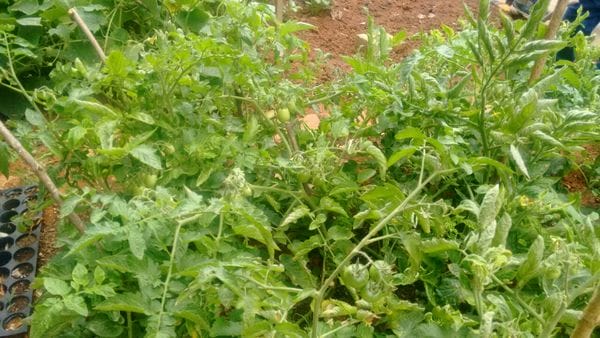‘Nurture your green patch’ is an initiative from Wipro to grow and harvest vegetables and other plants. It is an opportunity for employees to showcase and learn horticulture at the workplace.
Supported by the Sustainability and Facilities team, the Community Garden is flourishing at the Electronic City (EC4) campus of Wipro.
Living in urban spaces, we seem to be moving further away from natural environments. A large part of our lives is spent indoors staring at gadjets. Some of us are lucky to have found a favourite nature-spot around where we live and work to help us relax, unwind and be one with nature.

Pic: Lalithamba B V
Ten teams were given a 10×10 sq ft area of land and they could grow flowers, vegetables, spices of their choice on their green patch. These green patches are built along the circumference of the dome/Center Court which houses the campus cafeteria as a part of the EC 4 Biodiversity Park Project. The teams which comprise of more than 30 employees are part of Phase 1 of this program.
Nadana Sigamani, an external resource person/expert has been guiding the teams regularly by providing basic understanding in terms of how to plant, nurture and maintain the saplings on their patches. He has been a great help for the participants – be it clarifying doubts, helping to procure seeds, organising meetings near plots and giving feedback etc.

Pic: Lalithamba B V

Pic: Lalithamba B V

Pic: Lalithamba B V
Through this program, we are building connects with other ecology projects on campus. For example, recycled water from the campus is used for watering the patches. It has been a refreshing experience for employees as a lot of them attempted gardening for the first time. The teams tend to their patches during the lunch breaks and after hours. The gardening staff have also pitched in to make watering on the weekends easy. We also plan to start similar projects in other Wipro campuses.
The teams have made a great start and have harvested various vegetables like beans, palak, methi, raddish, amaranthus, onions, potatoes, tomatoes, cluster beans, cucumber, bitter gourd among others from their patches. A WhatsApp group has enabled live updates every day!
“It is heartening to see the enthusiasm and dedication amongst all team members. From sowing to harvesting, these teams are committed to the upkeep of their plots. Excited to see this initiative spread across and outside Wipro”- Arathi Hanumanthappa
Green Spots can be created at any place – be it home, neighborhood or at office. Growing some greens in office is absolute fun and it gives sense of stress-free atmosphere when we nurture the green patches at office after a daylong work in IT world. Green spots help us to unwind.
When the organisation proposed the idea of employees to grow and nurture their own patch, employees started by forming small teams. In the beginning, they sowed what they liked and were not so deeply involved. But once the greens started giving yield, the enthusiasm of teams increased. Each of us wanted to experiment with different kinds of produce. We have sown beans, palak, methi, raddish, amaranthus, onions, potatoes, tomatoes, cluster beans, cucumber, bitter gourd, drum sticks and list continues. We are eager to experiment more and each team is asking for more plots.
The Facilities and the gardening staff help with digging and watering over week ends and on request.
“Gardening is cheaper than therapy, plus you get to keep the produce” – Nadana Sigamani
I hope every corporate encourages their employees to grow and nurture some green patch and this is a good way of giving back to nature.
About Wipro’s initiatives
As a part of Wipro’s deep commitment to ecological sustainability Wipro has been involved with multiple environment related programs both, within our business ecosystem as well as in the civic and social sectors outside. Commonly called eco-eye, the inception of our sustainability program goes back to 2008. Eco-eye, helps introduce Wiproites to different perspectives in sustainability, and also allow them to understand their ability to make a difference in everyday lives.
Our urban biodiversity program includes the twin goals of (a) converting five of our existing campuses to biodiversity zones and (b) ensuring that all new campuses incorporate biodiversity principles into their design. Our first flagship project in the Electronic City campus in Bangalore was initiated two years back with the first phase of a unique Butterfly Park now completed. Our next phase includes an innovatively conceived wetland biodiversity zone that will use recycled water. For our Pune campus project, the first phase has seen a trebling of the number of species of flora and fauna from to more than 200+ native species.
While there are different initiatives in different locations that engage employees through the year-the months of May and June in particular are months where we host a series of engagement activities to familiarize and involve employees in specific areas to support the International day of Biological Diversity and World Environment Day respectively.
Related Articles
From garden city to garbage city – but pay more for the privilege
Planting a winter garden in your home
Gardening with ducklings
Find seeds for gardening in your own kitchen
Create your own herbal garden
Pick friends for your garden
Her garden is a heaven in the centre of the city
From garden city to garbage city – but pay more for the privilege
Planting a winter garden in your home
Gardening with ducklings
Find seeds for gardening in your own kitchen
Create your own herbal garden
Pick friends for your garden
Her garden is a heaven in the centre of the city